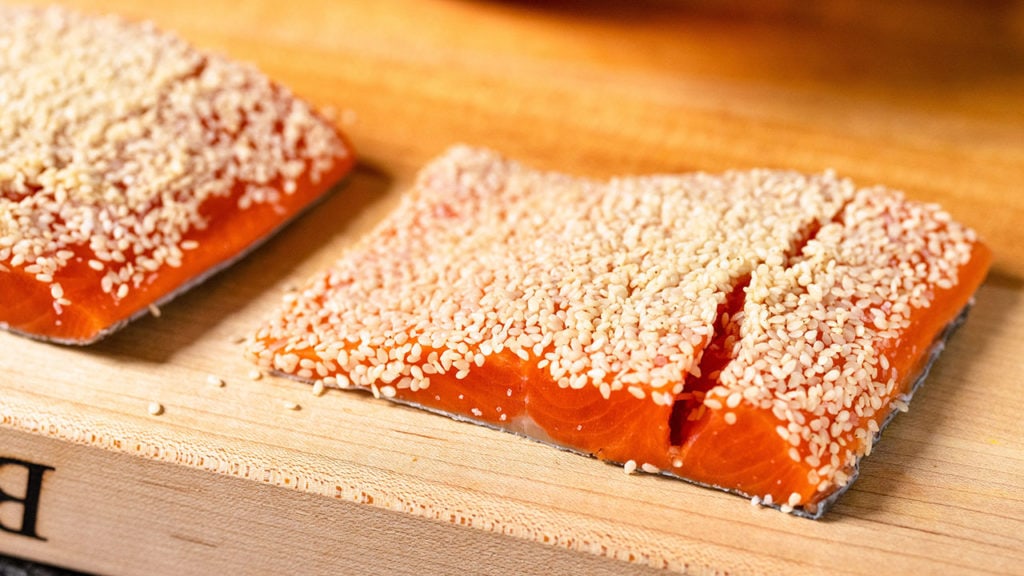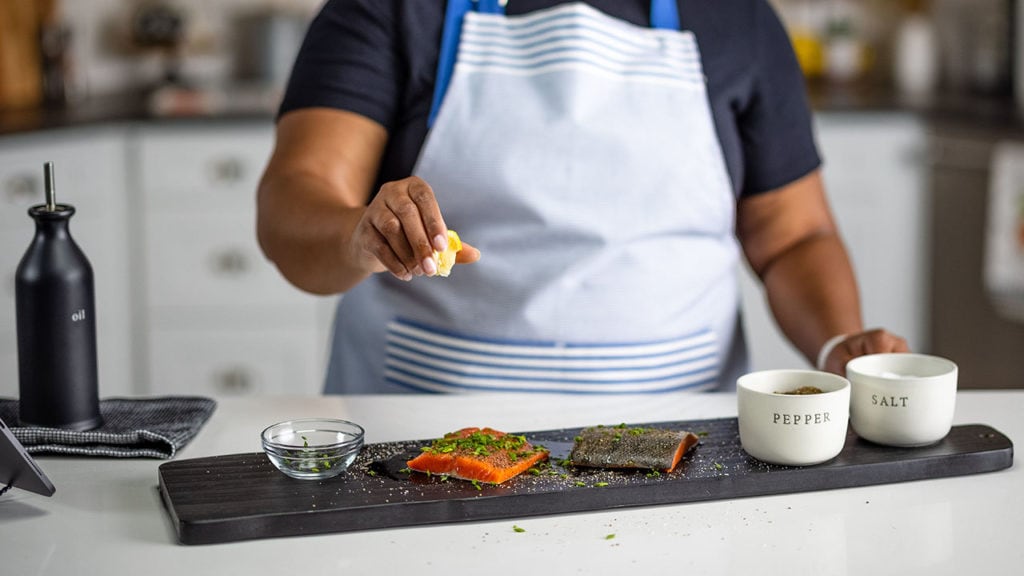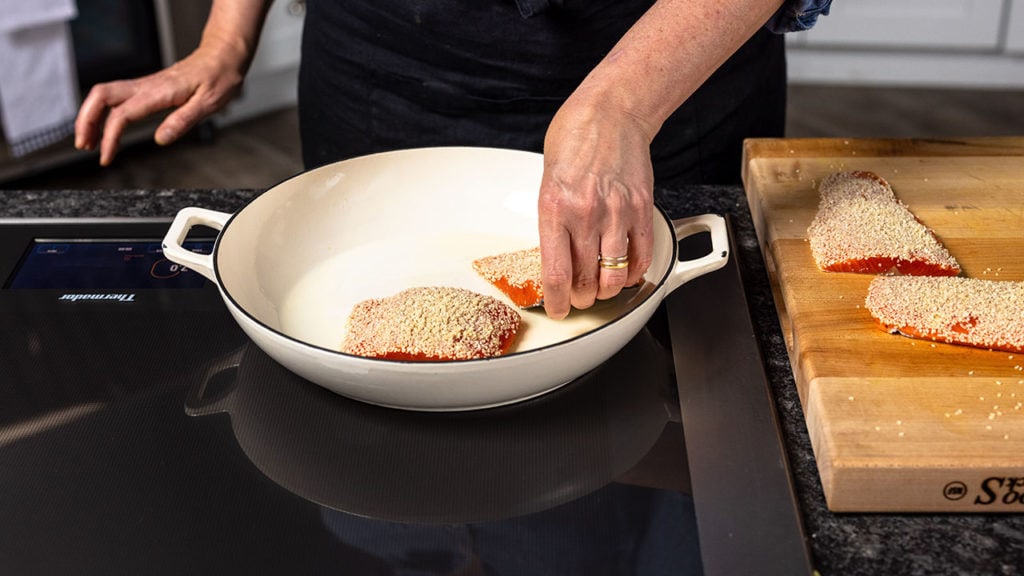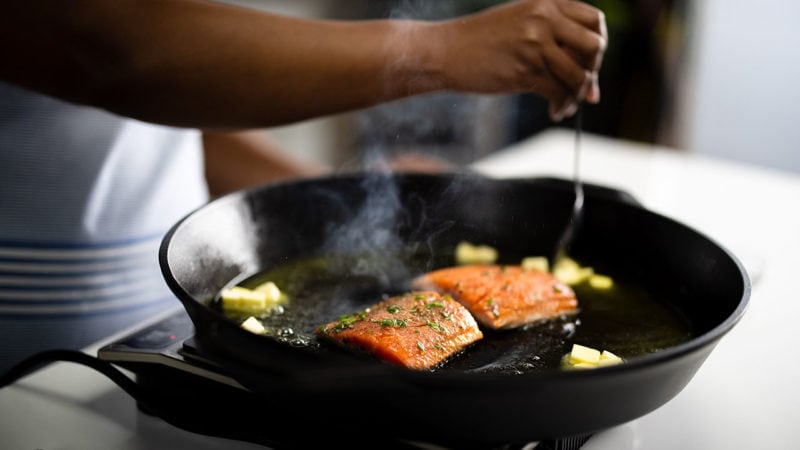Last Updated on February 25, 2022
Fish freaks some people out, it’s true. Seafood is known to be a lean and delicious source of protein that’s incredibly versatile from a culinary perspective. But Americans only eat about 16 pounds of it annually, with the majority consumed in restaurants.
Between selecting good fish, storing it properly, and cooking it well, fish at home can intimidate many home cooks—especially those who are newer to the kitchen.
At ButcherBox, one of our goals is to make people comfortable in their home kitchens, so we wanted to share some tips to help demystify the process of cooking fish at home.
Choosing the Best Fish

ButcherBox’s seafood offerings are all sustainably wild-caught and flash frozen. Though it might sound counterintuitive, the flash-freezing process means the seafood comes to you in as close to peak quality as you can get. Keep it frozen until you pick a night for cooking it, and thaw in the refrigerator.
Usually, this takes about 8 to 12 hours, so if you transfer the fish from the freezer to fridge in the morning, the fish will be ready in the evening. Larger cuts like salmon filets or cod will take longer than scallops or shrimp. Once thawed, the fish should still smell sweet and fresh. Use it within three days of thawing.
One thing to note: Don’t thaw seafood in vacuum-sealed packaging, remove it when it is frozen and place it into a freezer bag or other sealable container.
Get Ready to Cook

For the most part, you can treat seafood like any other protein when you’re getting ready to cook it. Pat the fish or shellfish dry before cooking. Bring it to room temperature before cooking so that the fish will cook more evenly once it hits the stovetop or oven.
When it comes to pre-seasoning your seafood, though, you don’t want to season fish ahead of time in the same way you would a steak or whole chicken. Season seafood right before cooking (and right after) so that the salt doesn’t pull too much moisture out of the fish.
In terms of cooking technique, fish is not only versatile but quick-cooking, which means that meals come together quickly but you also need to plan accordingly to get the timing right with the other components of the meal.
Minimize Fishy Smells

Having the kitchen smell like fish is one of the biggest deterrents to people cooking fish at home. The number one way to counter fish smells in the kitchen is cooking fish that’s super fresh. The second way is to choose methods that minimize the seafood’s exposure to the air, especially when paired with fat as in sauteeing or frying. Grilling outside is a no-brainer; high-heat roasting or braising are other methods that produce less smell.
Some experts recommend keeping a cup of vinegar or bleach open in the kitchen (away from the food) to help absorb the odors; using your hood vent if you have one is also a good idea. Finally, cleaning up soon after cooking will keep that tidal smell at bay ;).
Pick a Simple Technique
Don’t let the idea of cooking fish at home intimidate you. It’s simple to cook using a range of techniques.

Sear
Searing is a simple technique that’s used with certain cuts of beef, pork, and chicken all the time. Get a heavy-bottomed pan really hot, add some oil, and when the oil shimmers, add the fish and cook without moving it for a few minutes before flipping and letting it cook on the other side. The timing will vary depending on the size of the cut of fish. Searing browns the exterior of the seafood, which translates to deeper flavors.
Scallops and salmon both take well to this technique; like this recipe for seared scallops with lemon-bacon cream sauce or this one for seared salmon with white beans and snow peas.
Roast
Popping your fish in a hot oven to roast is another great way to cook it—fast, hands-off, and amenable to any number of flavor profiles. High heat (400°F to 450°) will help do the job quickly; adding aromatics and vegetables will bring the flavor, such as in this sheet-pan salmon dinner and this one-pan cod with tomatoes and corn.
Poach
Submerge fish in a barely simmering well-seasoned liquid (a quick stock with wine, a tomato-based situation, or even olive oil studded with citrus zest and whole spices), cover, and cook gently for just a few minutes. You’ll get a delicately flavored piece of fish with lovely texture and a ton of versatility in terms of serving.
Try this recipe for poached salmon with pickle sour cream, or this one for salmon with citrus and avocado.
Once you’re comfortable with these methods, you’ll have the confidence to branch out and try cooking seafood in all kinds of dishes, with all types of methods. And you’ll have a whole new category of dishes to add to your repertoire!
The ButcherBox Kitchen Team works hard to give you confidence you need to pull off any kitchen endeavor.



